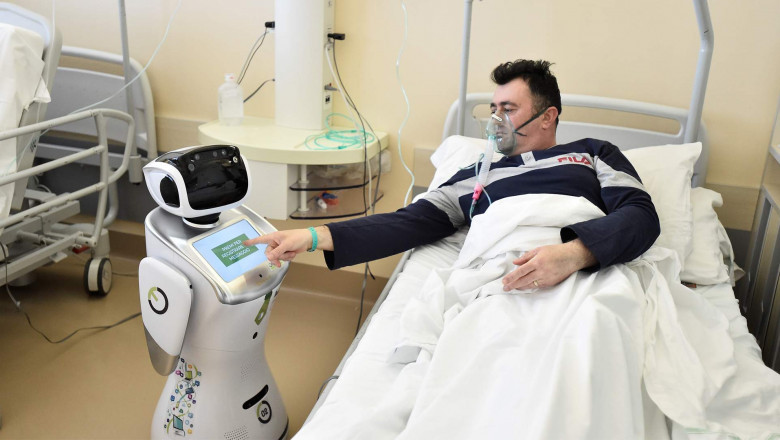views
The medical robot market is experiencing unprecedented growth as robotics technology continues to revolutionize healthcare. From surgical precision to rehabilitation support and remote monitoring, robots are becoming an integral part of healthcare systems worldwide. This article provides in-depth market intelligence, shedding light on the key drivers, technological advancements, and trends shaping the future of medical robotics.
Market Overview
Medical robots are designed to assist healthcare providers in performing tasks with increased precision, efficiency, and safety. These systems encompass a wide range of applications, including surgery, rehabilitation, diagnostics, hospital logistics, and telemedicine. As healthcare systems globally look for solutions to improve patient outcomes and reduce costs, the demand for robotic systems is growing rapidly.
The global healthcare landscape is transforming, and medical robots are at the forefront of this revolution. Their ability to handle complex procedures with minimal invasiveness, streamline workflows, and provide better patient care is propelling their adoption. According to market intelligence, this growth is driven by factors such as technological advancements, rising healthcare demands, and an increasing focus on automation.
Key Market Drivers
Several factors are driving the growth of the medical robot market, the most significant of which include:
-
Technological Advancements: Innovations in artificial intelligence (AI), machine learning, sensors, and real-time imaging are transforming the capabilities of medical robots. These advancements allow robots to perform intricate tasks, such as robotic-assisted surgery, with enhanced precision and reliability. AI also plays a crucial role in data analytics, enabling robots to learn and improve their performance over time.
-
Minimally Invasive Procedures: There is a growing demand for minimally invasive surgeries due to their reduced recovery times, lower risks, and better patient outcomes. Robotic systems, such as the da Vinci Surgical System, offer unmatched precision, allowing surgeons to perform delicate procedures through small incisions with greater control.
-
Aging Population: As the global population ages, the demand for medical procedures, especially in orthopedics, neurology, and cardiovascular care, is increasing. Robotic systems help meet this demand by enhancing the efficiency and outcomes of surgeries, making them indispensable in treating chronic conditions prevalent in the elderly.
-
Workforce Shortages: Healthcare providers are facing a shortage of skilled professionals, particularly in surgery and rehabilitation. Medical robots help alleviate this issue by assisting in routine tasks, allowing healthcare staff to focus on more critical care. In some cases, robots even facilitate remote procedures, enabling expert surgeons to operate from different locations.
Technological Innovations Shaping the Market
The integration of cutting-edge technologies is one of the most defining factors influencing the medical robot market. Key innovations include:
-
Artificial Intelligence (AI): AI enhances the decision-making process in medical robots, allowing them to provide personalized care and improve patient outcomes. AI-driven robots can analyze vast amounts of medical data, such as scans and patient histories, to recommend treatment options or assist in complex surgeries.
-
Telemedicine and Remote Surgery: The adoption of telemedicine has been accelerated by the COVID-19 pandemic, and medical robots are playing a pivotal role in enabling remote surgeries and consultations. Surgeons can operate robotic systems from miles away, using high-definition cameras, 3D imaging, and robotic arms, making expert care accessible to underserved regions.
-
Robotic Rehabilitation: In the field of rehabilitation, robots are assisting in physical therapy, particularly for patients recovering from strokes or surgeries. These robotic devices offer personalized recovery plans, track progress, and adjust therapy in real-time, speeding up recovery times and improving mobility.
Trends in the Medical Robot Market
As the medical robot market continues to evolve, several key trends are becoming apparent:
-
Robotic-Assisted Surgery: Robotic surgery remains the largest segment within the medical robot market. Advancements in robotic arms, high-definition imaging, and AI integration have made robotic-assisted surgery more accessible and effective. Surgeons can perform delicate operations with increased precision, reducing the risk of complications.
-
Increased Adoption in Developing Regions: While North America and Europe are currently the leading markets for medical robots, developing regions such as Asia-Pacific are showing rapid growth. Countries like China, India, and Japan are investing heavily in healthcare infrastructure and robotics, increasing the demand for advanced medical technologies.
-
Robotic Automation in Hospitals: Beyond surgeries, robots are being deployed for logistical tasks in hospitals, such as transporting medicines, medical supplies, and even cleaning and disinfection. The adoption of robotic automation in hospitals enhances operational efficiency, reduces human error, and ensures consistent care.
Challenges and Barriers
Despite the promising growth of the medical robot market, several challenges remain. One of the main obstacles is the high cost of robotic systems, including installation, maintenance, and training. Smaller healthcare facilities may find it difficult to justify the expense. Additionally, the lack of standardized regulations in some regions could hinder the market’s growth, as medical robots must meet strict safety and efficacy standards.
The Future of the Medical Robot Market
The future of the medical robot market looks incredibly promising, with growth expected to continue across various sectors. As robots become more affordable, efficient, and integrated with AI, they will play an even greater role in improving healthcare outcomes. The ongoing development of remote surgery capabilities, robotic rehabilitation systems, and AI-driven decision-making tools will further accelerate the market's growth.
Moreover, as healthcare systems worldwide continue to prioritize patient-centered care, medical robots will increasingly contribute to enhancing patient experiences, reducing recovery times, and improving surgical outcomes.
Conclusion
The medical robot market is poised for significant growth, driven by technological innovations, demographic shifts, and an increased focus on automation in healthcare. As robots become more integrated into healthcare delivery, they will redefine patient care, enhance clinical efficiency, and revolutionize surgery and rehabilitation. Continued advancements in AI and robotic technologies will further shape the future of healthcare, offering new opportunities for medical institutions worldwide.






















Comments
0 comment